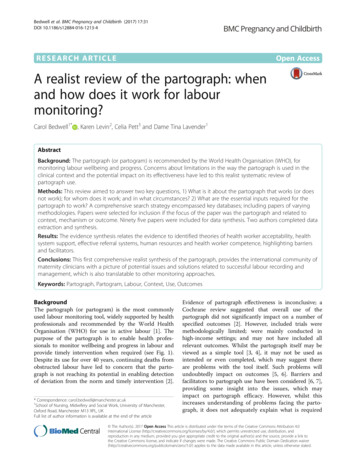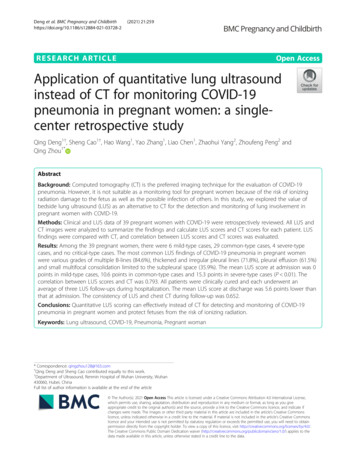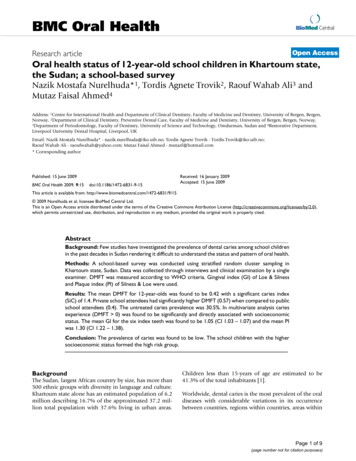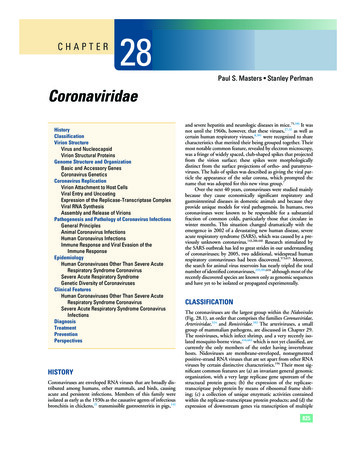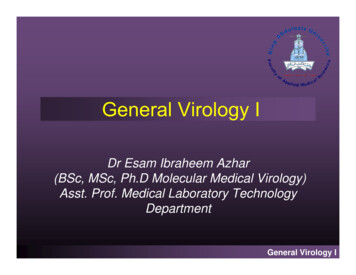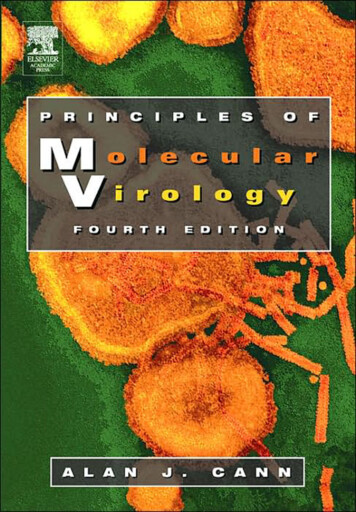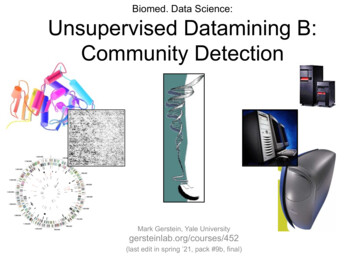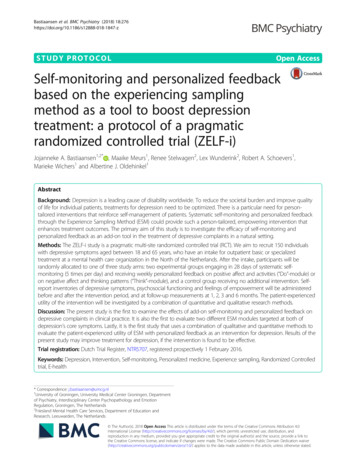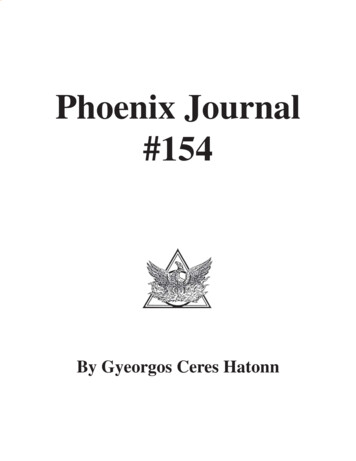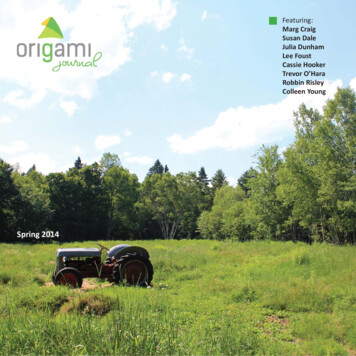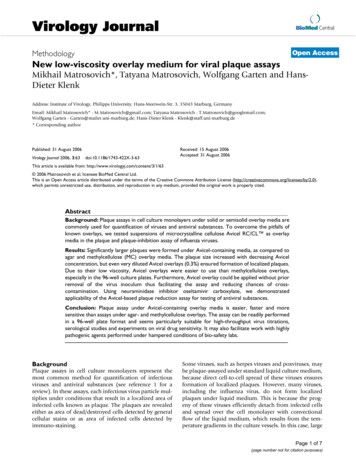
Transcription
Virology JournalBioMed CentralOpen AccessMethodologyNew low-viscosity overlay medium for viral plaque assaysMikhail Matrosovich*, Tatyana Matrosovich, Wolfgang Garten and HansDieter KlenkAddress: Institute of Virology, Philipps University, Hans-Meerwein-Str. 3, 35043 Marburg, GermanyEmail: Mikhail Matrosovich* - M.Matrosovich@gmail.com; Tatyana Matrosovich - T.Matrosovich@googlemail.com;Wolfgang Garten - Garten@mailer.uni-marburg.de; Hans-Dieter Klenk - Klenk@staff.uni-marburg.de* Corresponding authorPublished: 31 August 2006Virology Journal 2006, 3:63doi:10.1186/1743-422X-3-63Received: 15 August 2006Accepted: 31 August 2006This article is available from: http://www.virologyj.com/content/3/1/63 2006 Matrosovich et al; licensee BioMed Central Ltd.This is an Open Access article distributed under the terms of the Creative Commons Attribution License (http://creativecommons.org/licenses/by/2.0),which permits unrestricted use, distribution, and reproduction in any medium, provided the original work is properly cited.AbstractBackground: Plaque assays in cell culture monolayers under solid or semisolid overlay media arecommonly used for quantification of viruses and antiviral substances. To overcome the pitfalls ofknown overlays, we tested suspensions of microcrystalline cellulose Avicel RC/CL as overlaymedia in the plaque and plaque-inhibition assay of influenza viruses.Results: Significantly larger plaques were formed under Avicel-containing media, as compared toagar and methylcellulose (MC) overlay media. The plaque size increased with decreasing Avicelconcentration, but even very diluted Avicel overlays (0.3%) ensured formation of localized plaques.Due to their low viscosity, Avicel overlays were easier to use than methylcellulose overlays,especially in the 96-well culture plates. Furthermore, Avicel overlay could be applied without priorremoval of the virus inoculum thus facilitating the assay and reducing chances of crosscontamination. Using neuraminidase inhibitor oseltamivir carboxylate, we demonstratedapplicability of the Avicel-based plaque reduction assay for testing of antiviral substances.Conclusion: Plaque assay under Avicel-containing overlay media is easier, faster and moresensitive than assays under agar- and methylcellulose overlays. The assay can be readily performedin a 96-well plate format and seems particularly suitable for high-throughput virus titrations,serological studies and experiments on viral drug sensitivity. It may also facilitate work with highlypathogenic agents performed under hampered conditions of bio-safety labs.BackgroundPlaque assays in cell culture monolayers represent themost common method for quantification of infectiousviruses and antiviral substances (see reference 1 for areview). In these assays, each infectious virus particle multiplies under conditions that result in a localized area ofinfected cells known as plaque. The plaques are revealedeither as area of dead/destroyed cells detected by generalcellular stains or as area of infected cells detected byimmuno-staining.Some viruses, such as herpes viruses and poxviruses, maybe plaque-assayed under standard liquid culture medium,because direct cell-to-cell spread of these viruses ensuresformation of localized plaques. However, many viruses,including the influenza virus, do not form localizedplaques under liquid medium. This is because the progeny of these viruses efficiently detach from infected cellsand spread over the cell monolayer with convectionalflow of the liquid medium, which results from the temperature gradients in the culture vessels. In this case, largePage 1 of 7(page number not for citation purposes)
Virology Journal 2006, arallel plaque1assays in 6-well plates under agar overlay and overlays containing 1.2%, 0.6%, and 0.3% of Avicel RC-581Parallel plaque assays in 6-well plates under agar overlay and overlays containing 1.2%, 0.6%, and 0.3% of AvicelRC-581. MDCK cells were infected with influenza virus A/Memphis/14/96-M (H1N1) and immuno-stained using aminoethylcarbazole substrate (AEC).uneven foci of infected cells are formed, which cannot becounted (for examples, see Fig. 4 and Fig. 6a). To preventliquid movement in the culture vessels and to control viralspread, special overlay media are used. The most commonmethod is to solidify the culture medium with an agar (oragarose) gel. The solid gel overlays, however, cannot beused in 48- and 96-well culture plates required for auto-mated high-throughput assays. As an alternative to solidgels, viscous solutions of soluble hydrophilic polymers,methylcellulose (MC), carboxymethylcellulose, tragacanth gum, etc. can be employed [1].We recently developed a focus reduction assay of influenza virus sensitivity to neuraminidase inhibitors in 96well format under liquid medium [2]. Our efforts to perform this assay under MC overlays were discouraging dueto a high viscosity of methylcellulose-containing media.As described below, we overcame this problem byemploying new overlay media based on suspensions ofmicrocrystalline cellulose Avicel RC/CL (FMC Biopolymer). Avicel RC/CL is a colloidal form of water insolublecellulose microparticles blended with sodium carboxymethylcellulose to facilitate dispersion. Microparticles of Avicel are readily dispersed in water to formsuspensions and thixotropic gels used in the preparationof pharmaceutical suspensions and emulsions [3,4].These properties of Avicel, as well as the relatively low viscosity of Avicel-containing suspensions, prompted us totest whether such suspensions can be used as a convenientoverlay media in the plaque assay of the influenza virus.Results and discussionFigureParallel1.2%Avicelplaque2 RC-581assays(right)in 6-well plates under agar (left) andParallel plaque assays in 6-well plates under agar(left) and 1.2% Avicel RC-581 (right). Infection with A/Memphis/14/96-M (H1N1) in MDCK cells. Replicate cultureswere either immuno-stained with AEC (top) or stained withcrystal violet dye (bottom).Comparison of Avicel and agar overlaysWe first compared Avicel-based overlay media with standard agar overlay in the plaque assay in 6-well plates. Fig. 1illustrates results that were obtained in several replicateexperiments performed on different days. In all theseexperiments, larger plaques were formed under Avicelcontaining overlays, as compared to standard agar overlay. The plaque size increased with decreasing Avicel concentration, but even diluted Avicel overlays ensuredformation of well-localized plaques. Somewhat moreplaques were formed under Avicel than under agar, pre-Page 2 of 7(page number not for citation purposes)
Virology Journal 2006, 3:63http://www.virologyj.com/content/3/1/63Fig. 2 shows parallel assays under agar and Avicel overlayswith two commonly used methods of plaque detection,immuno-staining and staining with crystal violet, toreveal infected cells and destroyed cells, respectively. Avicel overlay performed better than agar overlay irrespectiveof the staining oncentrationassaysof Avicelunder(1.2%)(CL-661,overlaysRC-591preparedand RC-581)using threewithParallel plaque assays under overlays prepared usingthree different types of Avicel (CL-661, RC-591 andRC-581) with the same concentration (1.2%). Infectionwith A/Memphis/14/96-M (H1N1) in MDCK cells. Two replicate wells of the 6-well plate are shown for each overlay.Immuno-staining (AEC).sumably due to partial inactivation of the virus by heatedagar overlay.FMC BioPolymer produces three different types of hydrophylic microcrystalline cellulose, Avicel CL-661, AvicelRC-591 and Avicel RC-581 [3,4]. We compared them inthe same experiment using three different concentrationsfor each type, 1.2% (Fig. 3), 0.6%, and 0.3% (data notshown). The plaque size was independent of the Aviceltype, and the number of the plaques depended neither onthe Avicel type nor concentration. We arbitrarily used Avicel RC-581 in all subsequent experiments.Comparison of Avicel and methylcellulose overlaysHuman influenza virus formed rather small plaques inMDCK-SIAT1 cells under 1% methylcellulose overlay(Fig. 4), in part due to inherently reduced virus spread inthis genetically modified cell line [2]. Lowering MC concentration to 0.5% resulted in only marginal increase inthe plaque size, whereas utilization of 0.25% MC resultedin a formation of large comet-shaped foci. This peculiarshape of foci suggested that the virus progeny is carriedover the cell monolayer by convectional movement of theoverlay medium [5] and that 0.25% MC overlay fails toprevent such movement. By marked contrast, even themost diluted Avicel-based overlay (0.3%) efficiently prevented convectional flows in the culture medium whilestill allowing relatively unrestricted radial growth of theviral plaques. As a result, plaques formed under Avicelwere substantially bigger than those formed under MC.The number of plaques did not differ between the twotypes of overlays.Importantly, suspensions of Avicel are much less viscousthan solutions of methylcellulose used in plaque assays[1]. For example, 1.2% Avicel suspensions in water haveviscosity in the range of 100–200 mPa.s [3], whereas viscosity of 2% MC solution in water is 3000–5000 mPa.s[6]. Thus, even the most concentrated Avicel overlaymedia tested in our experiments (1.2%) was still significantly less viscous than the least concentrated ottomunderpanel)methylcellulose (top panel) andParallel plaque assays under methylcellulose (toppanel) and Avicel RC-581 (bottom panel). Numbersdepict concentrations of the MC and Avicel in the overlay. A/Memphis/14/96-M (H1N1); MDCK-SIAT1 cells in 6-wellplates; immuno-staining (AEC).Plaque formation by different influenza virus strainsWe tested eight human and avian influenza virusesbelonging to four HA and three NA antigenic subtypes forthe ability of these viruses to form plaques under Aviceloverlay (Fig. 5). All viruses, including highly pathogenicavian H5N1 and H7N7 viruses, produced readily countable plaques. Thus, Avicel overlays appear suitable forPage 3 of 7(page number not for citation purposes)
Virology Journal 2006, 3:63http://www.virologyj.com/content/3/1/63Figure 5Plaquesformed by influenza viruses in MDCK cells under 1.2% Avicel RC-581 overlayPlaques formed by influenza viruses in MDCK cells under 1.2% Avicel RC-581 overlay. Top row, from left to right:viruses isolated from humans A/Memphis/14/96-M (H1N1), A/Hong Kong/1/68 (H3N2), A/Hessen/1/03 (H3N2) and A/Thailand/KAN-1/04 (H5N1). Bottom row, from left to right: avian viruses A/Duck/Alberta/119/98, A/Duck/Minnesota/1525/81(H5N1), A/Chicken/Indonesia/1/05 (H5N1) and A/Chicken/Germany/R28/03 (H7N7). Immuno-staining with either True Blue(blue) or AEC (red).plaque assaying of a variety of influenza virus strains irrespective of their antigenic subtype and host species.Plaque assays under Avicel in 96-well platesAvicel overlays were readily compatible with the 96-wellmicroplate format. Due to their low viscosity, suspensionsof Avicel could be easily dispensed to and removed fromthe plate wells by using the standard equipment for handling liquid culture media (pipettes, dispensers, multiwell washer manifolds, etc).Plaque assays under agar and methylcellulose requireremoval of the initial viral inoculum before addition ofthe overlay [1]. The low viscosity of Avicel overlaysallowed us to skip this procedure making the assay easierto perform and reducing chances of cross-contaminationduring removal of the inoculums. In the experiment illustrated in Fig. 6, we infected MDCK-SIAT1 cells in a 96-wellplate with serial virus dilutions in the standard maintenance medium. One hour later, we either removed virusinoculum before adding the Avicel overlay medium (Fig.6b, replicate rows 5–8), or added the same Avicel mediumwithout removing the virus suspension from the wells(Fig. 6c, rows 9–12). Four replicate rows overlaid with theliquid medium served to illustrate a lack of plaque localization without the addition of Avicel (Fig. 6a). As can beseen, the simplified assay (c) was at least as sensitive as thestandard assay (b), and both assays had similarly lowwell-to-well variation.Assay of virus sensitivity to antiviral drugsFig. 7 demonstrates the applicability of the simplified Avicel-based assay for testing of antiviral substances. Onehour after infecting replicate MDCK-SIAT1 cultures ineither 6-well or 96-well plate with the virus mixtures withvariable amounts of neuraminidase inhibitor oseltamivircarboxylate, we added 1.2% Avicel overlay medium andincubated cultures for 3 days (a) and 24 hr (b), respectively. The results of the assays in 6-well plate and 96-wellplate closely agreed with each other and were consistentwith our previous data on sensitivity of this virus to oseltamivir carboxylate determined in the focus reductionPage 4 of 7(page number not for citation purposes)
Virology Journal 2006, 3:63http://www.virologyj.com/content/3/1/63based assays appear particularly suitable for highthroughput virus titrations, serological studies and experiments on viral drug sensitivity. Although tested here withinfluenza virus, the assay will likely be applicable to manyother viral infections, and it may substantially facilitatestudies on highly pathogenic agents performed underhampered experimental conditions of bio-safety labs.MethodsVirus and cellsUnless indicated otherwise, all experiments were performed using a clinical influenza virus isolate in MDCKcells A/Memphis/14/96-M (H1N1) kindly provided byDr. Robert Webster (St. Jude Children's Hospital, USA)[2]. The viruses described in Fig. 5 were kindly providedby the colleagues listed in the Acknowledgements.MDCK cells and MDCK-SIAT1 cells stably transfected with2,6-sialyltransferase for enhanced expression of Neu5Ac26Gal-terminated oligosaccharides were described previously [2]. We propagate
RC-591 and Avicel RC-581 [3,4]. We compared them in the same experiment using three different concentrations for each type, 1.2% (Fig. 3), 0.6%, and 0.3% (data not shown). The plaque size was independent of the Avicel type, and the number of the plaques depended neither on the Avicel type nor concentration. We arbitrarily used Avi- cel RC-581 in all subsequent experiments. Comparison of
